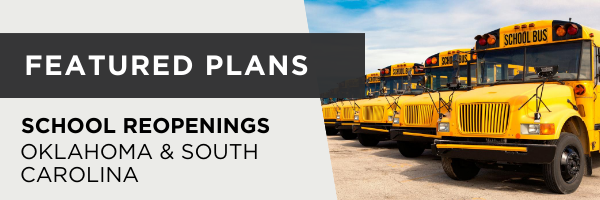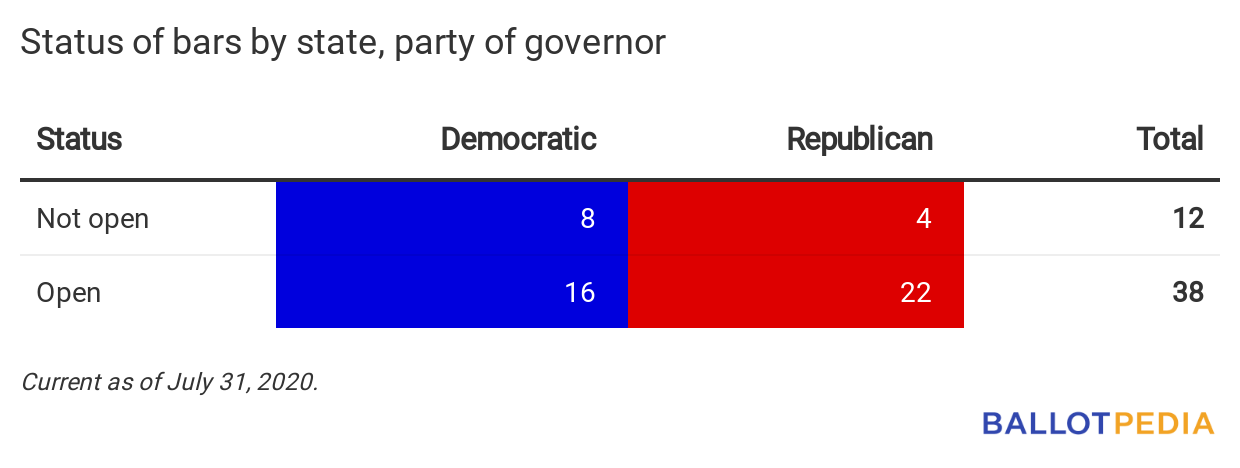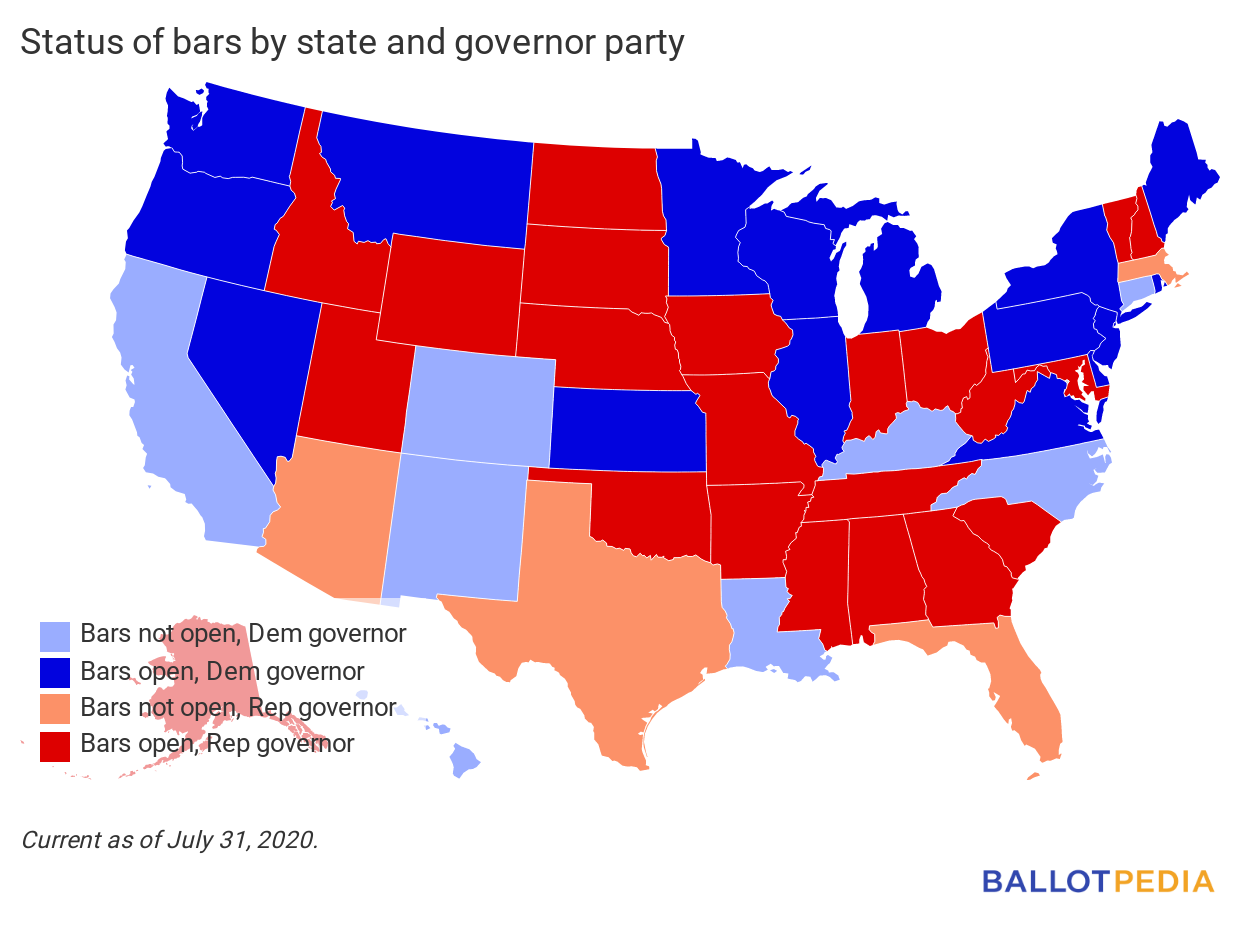Each day, we:
Want to know what happened yesterday? Click here. The next 72 hoursWhat is changing in the next 72 hours? August 1
Since our last editionWhat is open in each state? For a continually updated article on reopening status in all 50 states, click here. For our last edition, click here.
Tracking industries: BarsAll 50 states are reopening in some way. Here, we give the status of one industry or activity across the states. Today’s question: in which states may you go out for a drink? We last looked at bars in the July 24th edition of the newsletter. Since then, Washington began allowing outdoor seating at bars in certain regions. In Hawaii, bars closed in the only county where they were previously allowed to reopen. In Kentucky, bars went from being allowed to operate at 50% capacity to closed.
|
|||||||||||||||||||||||||||||||||||||||||||||||||||||||||||||||||||||||||||||||||||||||||||||||||||

This is an in-depth summary of two state plans to reopen public K-12 schools for the 2020-2021 school year. Return to Learn OklahomaThe Oklahoma State Department of Education released its school reopening guidance on June 3. Superintendent Joy Hofmeister said, “It is not necessary to act on every consideration in this comprehensive framework. Rather, in keeping with the guidance we have received from the U.S. Centers for Disease Control and Prevention (CDC) and Oklahoma health officials, districts should take a layered approach to COVID-19 mitigation, adopting those policies and practices that are feasible, practical and acceptable within their school community.” Oklahoma does not have an official date for public schools to reopen—individual districts can set their own timelines, depending on the virus’ effect on their community. According to EdWeek, public schools in Oklahoma traditionally start the academic year in mid-August, with the exact start date varying by district. On March 16, the Oklahoma Department of Education closed schools from March 17 to April 6. The Department closed schools for the remainder of the school year on March 25. ContextOklahoma is a Republican trifecta. The governor is a Republican, and Republicans hold majorities in both chambers of the state legislature. The state became a Republican trifecta in 2011. The following tables show public education statistics in Oklahoma, including a rank comparing it to the other 49 states. Rank one is the highest number of each figure, rank 50 is the lowest. All data comes from the Common Core of Data provided by the National Center for Education Statistics.
DetailsDistrict reopening plans School districts are encouraged to assemble a planning team to consider the recommendations put forth in the Return to Learn plan. Additionally, the document says districts should develop contingency plans in case schools need to close short-term or long-term and learning needs to be moved online. In-person, hybrid, and online learning The plan says school districts should plan to conduct most of the academic year on a traditional, in-person schedule. It also allows schools to conduct operations fully or partially online and encourages schools to develop online and hybrid options in case their community experiences a resurgence in coronavirus cases. Mask requirements The Department of Education allows school districts to develop their own policies on masks and other personal protective equipment. The plan notes that schools should encourage mask use when possible and says face coverings are especially recommended when social distancing cannot be practiced. In-person health recommendations and requirements The plan suggests school districts consider the following precautions to mitigate the spread of coronavirus and prepare for possible disruptions:
For more information on each of the above points, click here (starting on page 11). Transportation and busing requirements and restrictions Oklahoma’s school reopening plan recommends districts implement social distancing to the greatest extent possible, stagger schedules, and refer to CDC guidance. The plan also encourages districts to:
South Carolina’s AccelerateED Task Force recommendationsSuperintendent of Education Molly Spearman’s AcceleratED task force released recommendations for reopening schools on June 22. School districts are responsible for creating reopening plans based on these recommendations and in consultation with local public health officials. On March 15, Gov. Henry McMaster (R) closed schools statewide for two weeks. On March 24, McMaster extended the closure through April 30. The closure was made permanent for the rest of the school year on April 22. South Carolina does not have a statewide date for public schools to reopen. According to EdWeek, public schools in South Carolina may start no earlier than the third Monday in August (Aug. 17 this year), with the exact date varying by district. ContextSouth Carolina is a Republican trifecta. The governor is a Republican, and Republicans hold majorities in both chambers of the state legislature. The state has been a Republican trifecta since 2003. The following tables show public education statistics in South Carolina, including a rank comparing it to the other 49 states. Rank one is the highest number of each figure, rank 50 is the lowest. All data comes from the Common Core of Data provided by the National Center for Education Statistics.
DetailsDistrict reopening plans Districts are responsible for developing their own specific reopening plans in accordance with the AcceleratED recommendations and in consultation with local public health officials. The Department of Education (DOE) must approve all district plans. Those plans are posted publicly on the DOE website. In-person, hybrid, and online learning On July 14, McMaster said he would require all district plans to give parents the option to send students to school five days a week in addition to a virtual education option. McMaster instructed Spearman’s department not to approve plans that do not provide both options. A spokesman for Spearman said she disagreed with McMaster’s requirement for the in-person education option. “School leaders, in consultation with public health experts, are best positioned to determine how in-person operations should be carried out to fit the needs of their local communities. I remain committed to supporting them in this endeavor and will only approve those plans that offer high quality options and keep safety as their top priority,” she said. On July 27, Spearman approved the first six district reopening plans. Four of them included a five-day in-person learning option for at least some students. Mask requirements The task force recommendations defer to districts on mask requirements.
On July 31, Spearman announced that all staff and students in grades 2-12 would be required to wear masks in public school facilities. In-person health recommendations and requirements The task force recommended that schools consider the following when offering a fully in-person learning option:
The task force also issued the following recommendation for high schools:
Transportation and busing requirements and restrictions On July 27, Spearman issued an order requiring students and staff on state-owned school buses to wear masks at all times. She said buses will be able to operate at 67% capacity with the mask mandate. Initial task force recommendations mentioned guidelines from the South Carolina Department of Health and Environmental Control that set a 50% capacity limit for school buses. Reactions
Additional activityIn this section, we feature examples of other federal, state, and local government activity, as well as influencers relevant to recovering from the pandemic.
|
|||||||||||||||||||||||||||||||||||||||||||||||||||||||||||||||||||||||||||||||||||||||||||||||||||
Documenting America’s Path to Recovery: July 31, 2020
By



